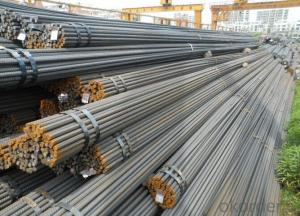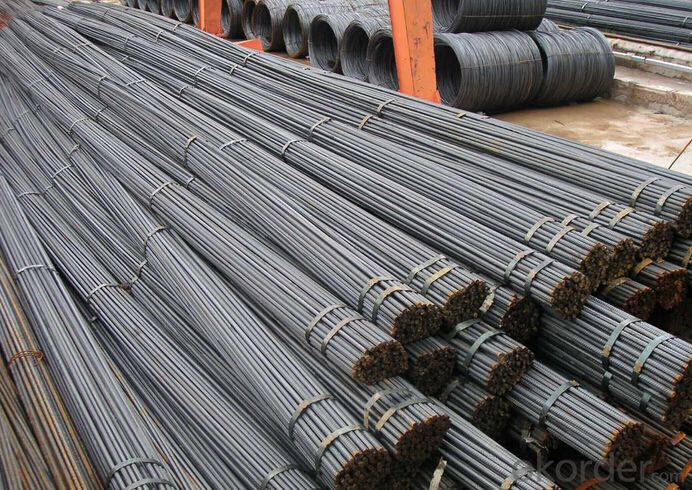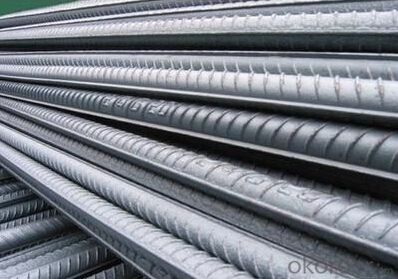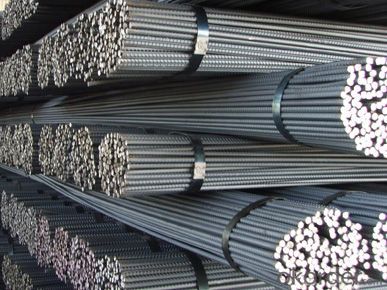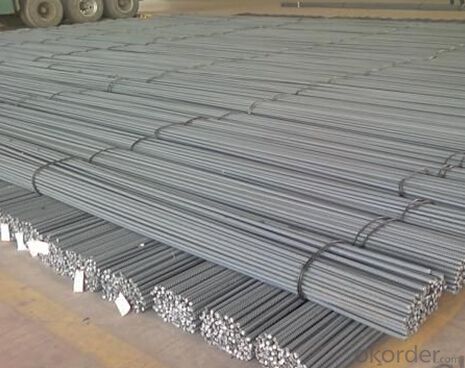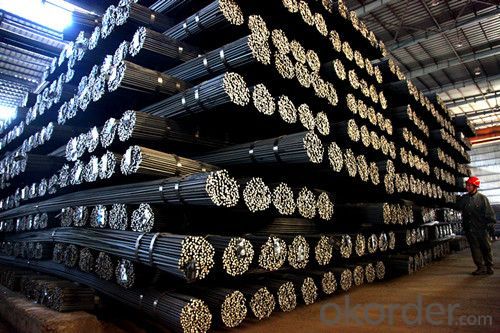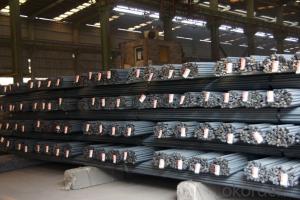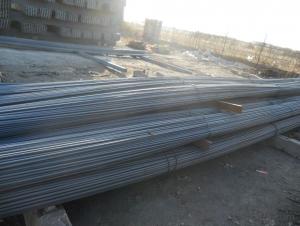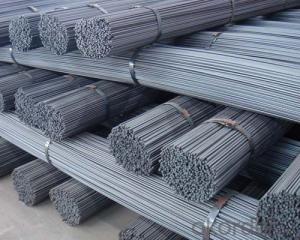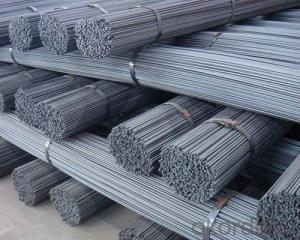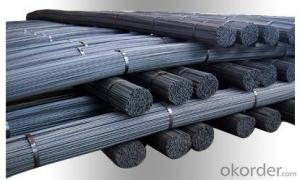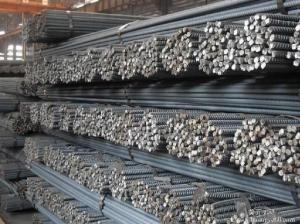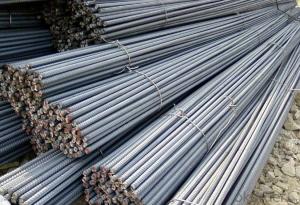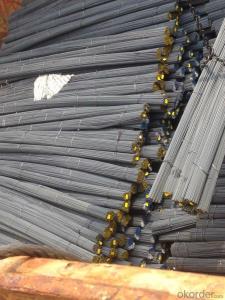HRB400 Deformed Steel Bar 12m Rebar for Construction
- Loading Port:
- Tianjin
- Payment Terms:
- TT OR LC
- Min Order Qty:
- 100 m.t.
- Supply Capability:
- 10000 m.t./month
OKorder Service Pledge
Quality Product, Order Online Tracking, Timely Delivery
OKorder Financial Service
Credit Rating, Credit Services, Credit Purchasing
You Might Also Like
Specification
Standard:
AISI,ASTM,JIS,GB,BS,DIN,API,EN
Technique:
Hot Rolled,Cold Rolled,Cold Drawn,ERW,Forged,Saw,Extruded,EFW,Spring
Shape:
U Channel,Square,C Channel,Hexagonal,Round,Rectangular,Oval,LTZ
Surface Treatment:
Galvanized,Coated,Copper Coated,Color Coated,Oiled,Dry,Chromed Passivation,Polished,Bright,Black,PVDF Coated
Steel Grade:
Q195,Q215,Q235,Q215B,Q235B,RHB335,HRB400,200 Series,300 Series,400 Series,600 Series,SS400-SS490,10#,20#,A53(A,B)
Certification:
ISO,SGS,BV,IBR,RoHS,CE,API,BSI,UL
Thickness:
6-34mm
Width:
6-34mm
Length:
12m
Outer Diameter:
6-32m
Net Weight:
10
Packaging:
Seaworthy packaging
HRB400 Deformed Steel Bar 12m Rebar for Construction
Details of the HRB400 Deformed Steel Bar 12m Rebar for Construction
| Standard & Grade: | GB1499-98 : HRB335,HRB400,HRB500 |
| BS4449-1997 : GR460,GR500 | |
| CAN/CSA-G30.18-M92 : 400W | |
| ASTM A615 : Gr.40, Gr.60 | |
| Diameter: | 6mm;8mm;10mm;12mm;14mm;16mm;18mm;20mm;22mm;25mm;28mm;30mm;32mm;35mm;40mm |
| Length: | 6m,9m,12m |
| Packing: | Bundle packing |
| Origin: | China |
| Application: | Construction,Road,Machinery processing,Welding fields. |
| Delivery time: | 10-25 days |
| Shipment: | By bulk vessel or Container |
| Documents: | Mill Test Certificate,Commercial Invoice,Packing List,Certificate of Origin |
Company Introduction of the HRB400 Deformed Steel Bar 12m Rebar for Construction
CNBM International Corporation is the most import and export platform of CNBM group(China National Building Material Group Corporation) ,which is a state-owned enterprise, ranked in 270th of Fortune Global 500 in 2015.
With its advantages, CNBM International are mainly concentrate on Cement, Glass, Iron and Steel, Ceramics industries and devotes herself for supplying high quality series of refractories as well as technical consultancies and logistics solution.
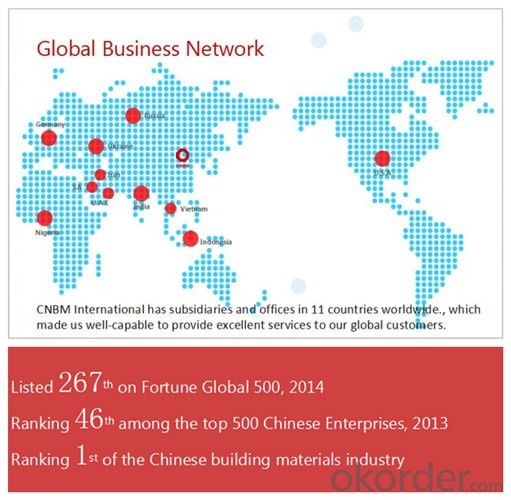
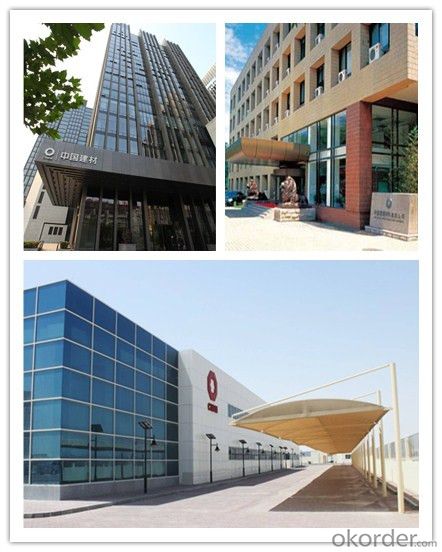
Packaging & Delivery of the HRB400 Deformed Steel Bar 12m Rebar for Construction
| Packaging Detail | Sea worthy packing /as per customer's packing instruction |
| Delivery Detail | 15 ~ 40 days after receiving the deposit |
FAQ
| Are you a trading company or manufacturer? | Manufacturer |
| What’s the MOQ? | 1000m2 |
| What’s your delivery time? | 15-20 days after downpayment received |
| Do you Accept OEM service? | Yes |
| what’s your delivery terms? | FOB/CFR/CIF |
| What's the Payment Terms? | 30% as deposit,70% before shipment by T/T |
| Western Union acceptable for small amount. | |
| L/C acceptable for large amount. | |
| Scrow ,Paybal,Alipay are also ok | |
| Why choose us? | Chose happens because of quality, then price, We can give you both. Additionally, we can also offer professional products inquiry, products knowledge train (for agents), smooth goods delivery, excellent customer solution proposals. |
| What's your available port of Shipment? | Main Port, China |
| What’s your featured services? | Our service formula: good quality+ good price+ good service=customer's trust |
| Where are your Market? | Covering more than 160 countries in the world |
- Q: What is the effect of steel rebars on the formwork design?
- The presence of steel rebars in formwork design provides structural reinforcement and improves the overall strength and durability of the structure. The rebars help distribute the load and forces more effectively, allowing for the creation of thinner and lighter formwork designs. Additionally, steel rebars can be used to reinforce specific areas or joints where additional strength is required. Overall, incorporating steel rebars in formwork design enhances the structural integrity and longevity of the construction project.
- Q: Are steel rebars suitable for use in industrial facilities?
- Yes, steel rebars are highly suitable for use in industrial facilities. Steel rebars are commonly used in construction projects to reinforce concrete structures, and their robustness and strength make them ideal for industrial facilities where heavy loads and high-stress environments are common. The use of steel rebars helps enhance the structural integrity and load-bearing capacity of the facility, ensuring it can withstand the demands of industrial operations. Additionally, steel rebars are highly resistant to corrosion, which is a crucial factor in industrial settings where exposure to moisture, chemicals, and other corrosive substances is prevalent. Overall, steel rebars provide the necessary strength, durability, and corrosion resistance required for industrial facilities, making them a suitable choice for reinforcing concrete structures in such environments.
- Q: What are the factors that can affect the lifespan of steel rebars in concrete structures?
- There are several factors that can affect the lifespan of steel rebars in concrete structures. Firstly, the quality and composition of the concrete used in the structure play a significant role. If the concrete is of poor quality or contains harmful chemicals, it can cause corrosion of the steel rebars, leading to a shorter lifespan. Adequate measures should be taken during the construction process to ensure the concrete mixture is properly proportioned and cured. Secondly, the exposure conditions that the concrete structure is subjected to can greatly impact the lifespan of steel rebars. Factors such as humidity, temperature variations, and the presence of aggressive substances like chloride ions or carbon dioxide can accelerate the corrosion process. Structures located in coastal areas or industrial environments are particularly vulnerable due to the high salt content in the air or the presence of pollutants. Thirdly, the design and construction practices employed have a significant impact on the longevity of steel rebars. Proper cover thickness, which refers to the distance between the surface of the rebar and the outer face of the concrete, is crucial. Inadequate cover thickness can lead to insufficient protection against corrosion. Additionally, the design should incorporate effective drainage systems to prevent the accumulation of water around the rebars, as stagnant moisture can accelerate corrosion. Furthermore, maintenance practices also play a role in the longevity of steel rebars. Regular inspections, cleaning, and repairs can help identify and address any issues before they become severe. Applying protective coatings or using corrosion inhibitors can also extend the lifespan of the rebars. Lastly, the type and quality of the steel rebars themselves are important factors. Rebars with higher levels of carbon and alloying elements are generally more resistant to corrosion. Additionally, the quality of the manufacturing process and the presence of any impurities can affect the rebars' durability. In conclusion, the lifespan of steel rebars in concrete structures can be influenced by various factors including the quality of the concrete, exposure conditions, design and construction practices, maintenance, and the quality of the rebars themselves. Proper attention to these factors can help ensure the longevity and structural integrity of concrete structures.
- Q: What are the considerations for using epoxy-coated steel rebars?
- When it comes to epoxy-coated steel rebars, there are several important factors that need to be taken into account. These factors include corrosion resistance, durability, cost-effectiveness, and construction requirements. One of the main factors to consider is the corrosion resistance provided by epoxy-coated steel rebars. The epoxy coating acts as a protective barrier against moisture, chemicals, and other corrosive elements commonly found in concrete structures. This coating significantly reduces the risk of corrosion, thereby increasing the lifespan of the rebar and the overall durability of the reinforced concrete. Durability is another crucial consideration. Epoxy-coated steel rebars are specifically designed to withstand harsh environmental conditions, including exposure to chloride ions that are known to accelerate corrosion in traditional black steel rebars. This enhanced durability ensures the structural integrity of the building over a longer period, reducing the need for expensive repairs or replacements. Cost-effectiveness is also an important factor to think about. Although epoxy-coated steel rebars may have a higher initial cost compared to black steel rebars, their long-term cost-effectiveness is evident. The reduced risk of corrosion and subsequent maintenance or repair expenses can result in significant savings over the lifespan of a structure. Additionally, the extended lifespan of the rebar can contribute to lower life-cycle costs. Construction requirements must also be considered when using epoxy-coated steel rebars. The application of the epoxy coating requires careful handling and storage to prevent damage or contamination. Special precautions must be taken during transportation, storage, and installation to maintain the integrity of the coating. Contractors must also undergo training and possess experience in working with epoxy-coated steel rebars to ensure proper installation and adherence to industry standards. In conclusion, the considerations for using epoxy-coated steel rebars encompass corrosion resistance, durability, cost-effectiveness, and specific construction requirements. Despite the higher initial cost and the need for additional care during handling and installation, the long-term benefits of increased corrosion resistance and durability make them a favorable choice for reinforced concrete structures.
- Q: What is the resistance of steel rebars against acid attacks?
- Due to the protective layer of rust that forms on their surface, steel rebars exhibit a high resistance to acid attacks. This layer, commonly known as iron oxide, acts as a barrier, effectively preventing direct contact and corrosion between the steel and the acid. Furthermore, the steel rebars' resistance to acid attacks is enhanced by their high carbon content, which results in the formation of a protective film that provides additional shielding from acid damage. However, it is important to bear in mind that extended exposure to highly concentrated or corrosive acids may still cause some degree of corrosion, although at a slower pace compared to other metals. Therefore, it is recommended to carefully choose the appropriate grade of steel rebar and implement supplementary protective measures, such as coatings or concrete coverings, in order to ensure optimal resistance against acid attacks in specific applications.
- Q: What are the guidelines for protecting steel rebars during concrete placement and compaction?
- To ensure the structural integrity and durability of the concrete structure, it is essential to adhere to guidelines for safeguarding steel rebars during concrete placement and compaction. Here are some key guidelines to consider: 1. Covering and Support: Adequate coverage and support are necessary to shield rebars from corrosion and damage. The minimum cover requirements specified in the design or relevant standards must be met. Additionally, rebars should be positioned accurately, avoiding direct contact with the ground or formwork. 2. Cleanliness: Prior to concrete placement, thorough cleaning of rebars is crucial to eliminate rust, scale, dirt, or other contaminants. This can be achieved through wire brushing, sandblasting, or other appropriate methods. Clean rebars promote better bonding with the concrete and reduce the risk of corrosion. 3. Moisture Control: During concrete placement and compaction, rebars should remain dry. Excessive moisture, particularly in high humidity or chloride-exposed areas, can accelerate corrosion. To prevent moisture accumulation, proper drainage systems and the use of waterproofing membranes are recommended. 4. Spacing and Tying: Adequate spacing and tying of rebars are necessary to maintain the desired concrete cover and prevent displacement during placement and compaction. This ensures proper embedding of rebars in the concrete, providing the required structural strength. 5. Vibrating and Compaction: Care should be taken to avoid direct contact between the vibrator and rebars during concrete placement, as this can cause damage or displacement. Vibrating should be done carefully and gradually to ensure uniform and tight compaction of the concrete around the rebars. 6. Concrete Placement Techniques: Proper techniques for concrete placement should be followed to minimize the risk of rebar displacement. Gentle and even placement of concrete should be prioritized, avoiding excessive dropping or splashing that could displace rebars. Additionally, proper compaction and consolidation techniques should be employed to eliminate voids and fully encapsulate rebars. 7. Protection from External Factors: Rebars should be protected from environmental factors that can induce corrosion, such as moisture, chemicals, or aggressive soils. Adequate curing of the concrete is vital to prevent rapid drying or carbonation, which can lead to corrosion and reduced durability. By adhering to these guidelines, rebars can be effectively protected during concrete placement and compaction, ensuring the long-lasting and safe nature of the concrete structure. It is advisable to consult relevant design codes, specifications, and industry best practices for project-specific guidelines.
- Q: Can steel rebars be used in heritage bridge restoration?
- Yes, steel rebars can be used in heritage bridge restoration. Steel rebars provide strength and durability to reinforce the existing structure and ensure its stability and longevity. However, it is important to maintain the historical integrity of the bridge during restoration and use rebars that are compatible with the original materials and design.
- Q: What are the guidelines for repairing damaged steel rebars in a structure?
- When it comes to repairing damaged steel rebars in a structure, there are several guidelines that need to be followed to ensure the structural integrity of the building. Here are some key guidelines: 1. Inspection: Before starting the repair process, a thorough inspection of the damaged rebars should be conducted. This includes assessing the extent of the damage, identifying the cause of the damage, and determining whether repair is feasible or if replacement is required. 2. Cleaning: The damaged rebars need to be cleaned properly to remove any loose rust, scale, or other contaminants. This can be done using wire brushes, sandblasting, or other appropriate cleaning methods. 3. Removal of damaged material: Any corroded or severely damaged portions of the rebars should be removed. This may involve cutting out the damaged area and replacing it with a new rebar, or using techniques such as welding or epoxy bonding to repair the damaged section. 4. Surface preparation: The surface of the rebars should be prepared to ensure proper adhesion of the repair material. This may involve roughening the surface, applying a bonding agent, or using other surface preparation techniques depending on the specific repair method being employed. 5. Repair material selection: The choice of repair material will depend on factors such as the severity of the damage, the load-bearing capacity required, and the environment in which the rebars are located. Common repair materials include epoxy resins, cementitious mortars, or other specialized repair products. 6. Repair technique: The repair technique chosen should be appropriate for the specific damage and should comply with relevant industry standards and codes. Techniques such as welding, epoxy bonding, or mechanical splicing can be used to repair damaged rebars. 7. Quality control: Throughout the repair process, quality control measures should be implemented to ensure the effectiveness and durability of the repair. This may involve testing the repaired rebars for strength, monitoring the curing process, and conducting inspections to verify that the repairs have been carried out in accordance with the guidelines. 8. Documentation: It is essential to maintain thorough documentation of the repair process, including photographs, test results, and any relevant certifications or warranties. This documentation can be useful for future reference, maintenance, and to provide evidence of the repair work done. It is important to note that the guidelines for repairing damaged steel rebars may vary depending on the specific requirements of each project, local building codes, and the recommendations of structural engineers or repair specialists. Therefore, it is crucial to consult with experts in the field to ensure that the repair work is carried out safely and effectively.
- Q: Are steel rebars recyclable?
- Yes, steel rebars are recyclable. They can be melted down and used to produce new steel products, reducing the need for raw materials and promoting sustainability in the construction industry.
- Q: How do steel rebars affect the overall load distribution of concrete structures?
- Steel rebars significantly affect the overall load distribution of concrete structures by providing tensile strength and reinforcing the concrete. The rebars absorb and distribute the applied load throughout the structure, reducing the risk of cracking and enhancing the structural integrity. Without rebars, concrete structures would be more prone to failure under heavy loads or external forces.
Send your message to us
HRB400 Deformed Steel Bar 12m Rebar for Construction
- Loading Port:
- Tianjin
- Payment Terms:
- TT OR LC
- Min Order Qty:
- 100 m.t.
- Supply Capability:
- 10000 m.t./month
OKorder Service Pledge
Quality Product, Order Online Tracking, Timely Delivery
OKorder Financial Service
Credit Rating, Credit Services, Credit Purchasing
Similar products
Hot products
Hot Searches
Related keywords
